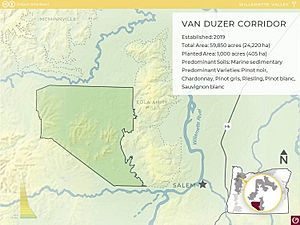Van Duzer Corridor AVA facts for kids
| Wine region | |
| Type | American Viticultural Area |
|---|---|
| Year established | 2019 |
| Country | United States |
| Part of | Oregon, Willamette Valley AVA |
| Other regions in Oregon, Willamette Valley AVA | Chehalem Mountains AVA, Dundee Hills AVA, McMinnville AVA, Eola-Amity Hills AVA, Ribbon Ridge AVA, Yamhill-Carlton AVA |
| Climate region | Maritine |
| Soil conditions | Marine sediment with basalt over siltstone bedrock |
| Total area | 59,871 acres (24,229 ha) |
| Size of planted vineyards | 1,000 acres (405 ha) |
| No. of vineyards | 18 |
| Varietals produced | Pinot noir, Pinot gris, Pinot blanc, Sauvignon Blanc, Chardonnay, Riesling, Viognier |
| No. of wineries | 9 |
The Van Duzer Corridor AVA is a special area in Oregon, United States. It's part of the larger Willamette Valley AVA, which is known for growing grapes. This area was officially recognized as an American Viticultural Area (AVA) in 2019.
An AVA is like a special zone for growing grapes. It means the grapes grown there have unique qualities because of the land and weather. The Van Duzer Corridor AVA covers about 59,871 acres. It has 18 vineyards and 9 wineries that make wine.
Contents
What Makes Van Duzer Corridor Special?
The Van Duzer Corridor AVA is unique because of three main things: its land shape, its weather, and its soil. These features work together to create perfect conditions for growing certain types of grapes.
Land Shape (Topography)
The land in the Van Duzer Corridor AVA has low elevations and gentle, rolling hills. This is important because it allows cool breezes to blow in from the Pacific Ocean. These winds travel through a gap in the Oregon Coast Range called the Van Duzer corridor.
The western part of this wind gap is narrow. But the eastern part, where the AVA is located, is wider. This wider area has the same low hills, which means the strong ocean winds can flow through easily. These winds help the grapes grow in a special way. Other areas nearby have higher hills that block the wind.
Weather (Climate)
The weather in the Van Duzer Corridor AVA is known for its strong, steady winds. It also has cooler temperatures overall. These strong winds help the grapes develop thicker skins. Thicker skins mean the grapes have more "phenolic compounds." These compounds are important for the color, taste, and feel of the wine.
The cooler temperatures in the AVA mean the grapes ripen slowly. This "longer hang time" allows the grapes to stay on the vine for a longer period. This slow ripening helps to reduce the acidity in the grapes, making the wine taste smoother. Areas around the AVA have less wind and warmer temperatures, which means grapes ripen faster there.
Soil Types
The soils in the Van Duzer Corridor AVA are mostly made of marine sediment. This means they were formed from the ocean floor long ago. They are a mix of loams and silts, with some alluvial (river-deposited) material. There's also some basalt, which is a type of volcanic rock.
These soils are usually shallow and drain water well. They sit on top of siltstone bedrock. The high levels of silt and clay in the soil help keep the soil's pH level stable. This "buffering effect" is good for vineyards because it helps the grapes grow consistently. Soils outside the AVA have different compositions, with more volcanic material or Ice Age loess.


